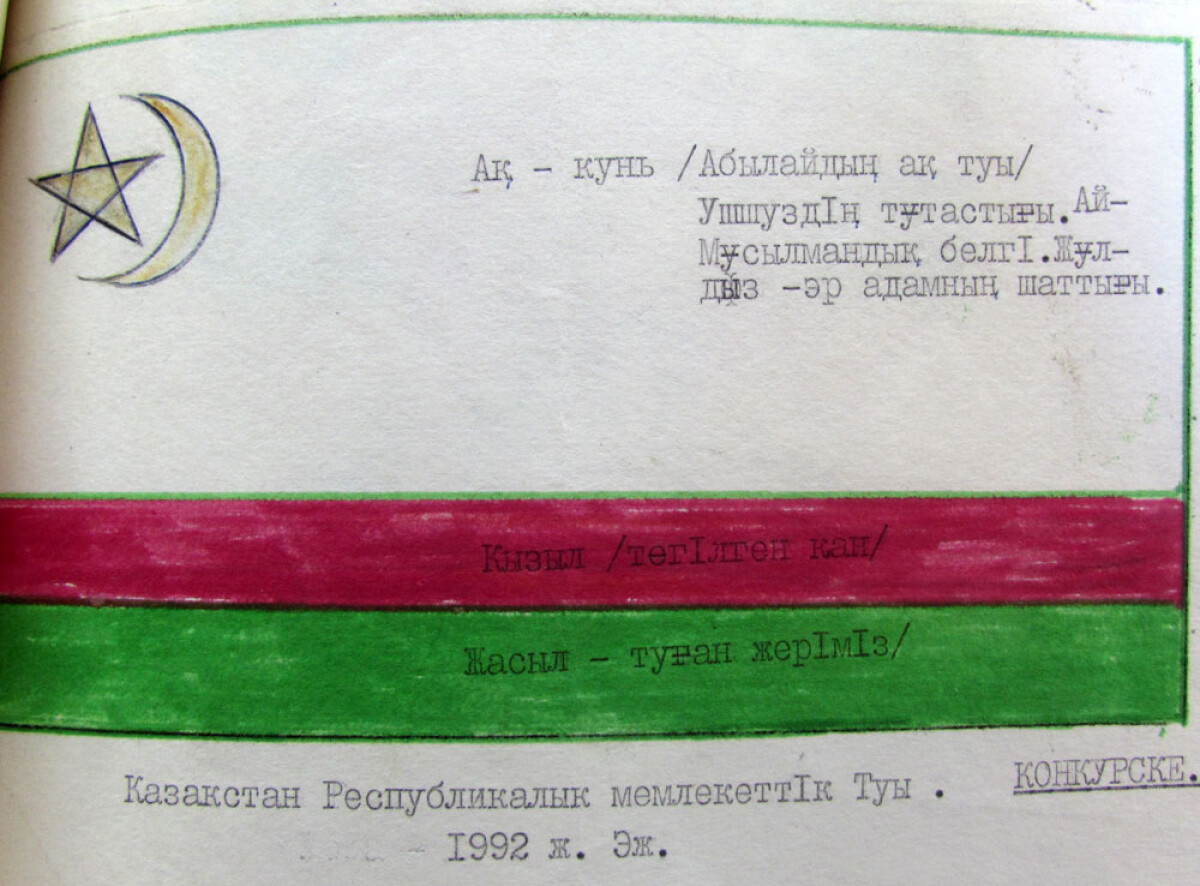
In connection with the proclamation of the state independence of the Republic of Kazakhstan, the Supreme Council of the Republic of Kazakhstan decided to form a working group for the preparation of new state symbols (coat of arms, flag, anthem) of the Republic of Kazakhstan.
Created by the Presidium of the Supreme Council of the Republic of Kazakhstan on January 2, 1992, the working group on the preparation of new state symbols of the Republic of Kazakhstan announced a truly national contest for the best projects of state symbols of the Republic of Kazakhstan. Professional and amateur authors, residents of all regions of the republic, representatives of different nationalities, as well as compatriots living outside of Kazakhstan participated in this contest. For four months, the group was working on a draft of the flag and the coat of arms.
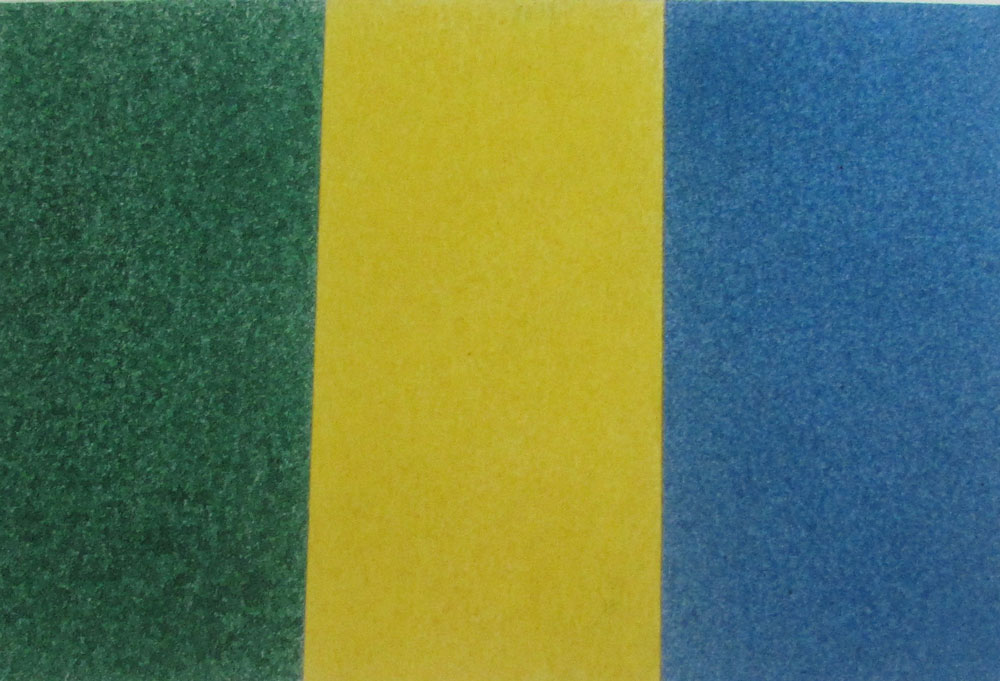
Project of the National Flag. Authors of the project Duisenov S.T., Redko S.L. 1992
The working group held 14 meetings in which 453 sketches and 142 letters on the draft of the National Flag, 245 sketches and 67 letters on the draft of the State Emblem and 51 version of the musical version of the National Anthem project were considered with the participation of the public.
The draft flag favorably differed from the existing national flag of the 1953 model. At the heart of the latter is a red color, embodying the color of blood which was shed in the revolutionary struggle. From the point of view of the canons of heraldry, red means threat, rebellion. The class approach explains the presence on this flag of the image of a sickle and a hammer (as an alliance of the peasantry and the working class) and a five-pointed red star, supposedly symbolizing the solidarity of the working people of the five continents in the name of the communist future. The only differences between the flags of the former union republics were the bands of different colors located on them, which in no way reflected their national identity.
At the heart of the project of the new flag lay common human values, awareness of the role and place of Kazakhstan in the world community. Therefore, the choice was made in favor of blue color, recognized by the peoples of the world. If we turn again to heraldry, blue color personifies honesty, fidelity, hope. For example, the flag of the United Nations - blue, the European Parliament - blue. The color chosen by the working group reflects a clear and cloudless sky, which, in turn, always personifies peace, unity, tranquility and prosperity.

Project of the National Flag. The author of the project Sultanbekov M.T. December, 1991
Another important element of the composition of the flag is the eight-pointed star, which is formed from the imposition of two squares, the sign of eternity. One of them is turned into the past, and the other into the future. The eight-pointed star is present in the symbols of many peoples of the world. Since ancient times in Eurasia was an eternal constructive symbol, which was the basis of many concepts, figurative elements. In Kazakh ornaments, there is a symmetrical construction of all elements and symbols. Any symbol, any ornamentation is built on an octagonal combination, on a clear combination. Examples include all monuments of material culture that are on the territory of Kazakhstan. The monument that has survived to our time is the mausoleum of Khoja Ahmet Yassawi. All of its basic ornamental symbolism is built on an octagon. The dome of the mausoleum of Khoja Ahmet Yassawi is built on the quadrangle, which goes to the octagon and then holds the sky. Mausoleum of Aisha Bibi. All the basic ornamentation is built on the octagonal symbolic construct. Any ornament in the monumental architecture and in the subject of plastic architecture is octagonal. This octagonal star is a symbol of our thoughts and our dream of freedom and happiness. Three of these symbols are enduring elements of the original symbolism of the people.
Octagonal or eight-ray star. The world, indeed, is diverse, diverse sensations. People in history have seen, felt, mystified the world in different ways. The European peoples represented this star as a five-beam star. In the East, in Ancient India, in America, in some countries of Latin America, an octagonal star is still accepted. In the Kazakh applied art in the form of an eight-pointed star, the morning star was depicted Venus. So this is a historical tradition. The secret of the 8-pointed star is shanyrak. With its rays it covers all sides of the horizon, which indicates the triumph of life everywhere. It symbolizes the high point of Kazakhstan as an independent state.
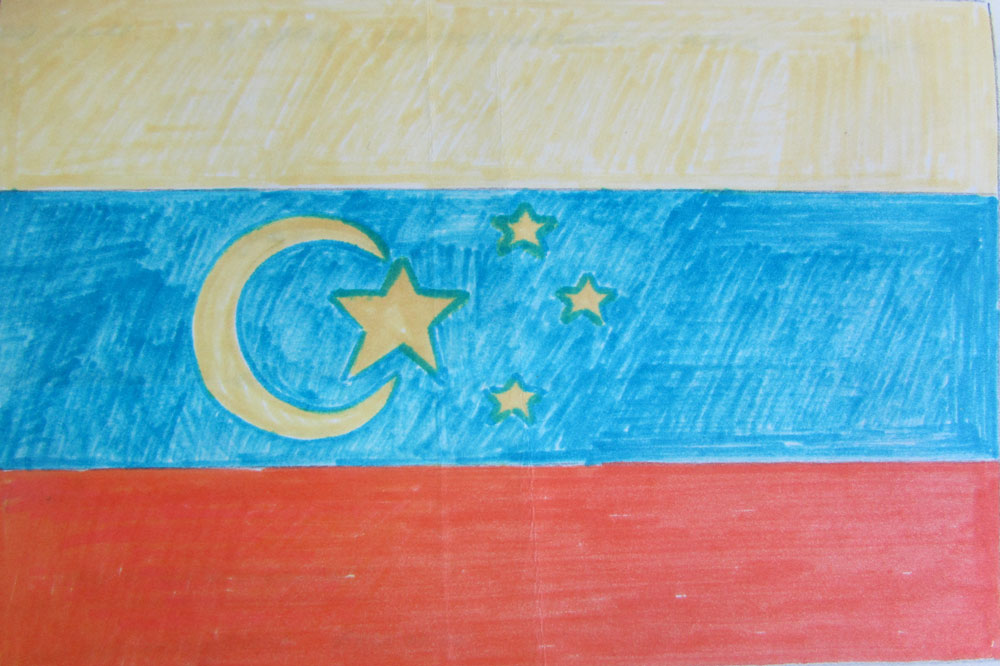
Project of the National Flag. 1992
The young moon completes the composition of the flag. In this case, its neighborhood with shanyrak, according to popular beliefs, ensures success in small and large businesses. According to the authors' intention, it testifies to Kazakhstan's aspirations as a democratic and law-based state, to take a worthy place in the international community. That’s why they say: let the moon be born on the right, and the star on the left.
In his speech, Chokan Valikhanov explained the appearance of the sign of the moon on the flag. Finding shanyrak near the moon speaks about the high position of Kazakhstan in the world. Our flag is blue, like the sky itself. On it there are no artificial lines or lurid color overlays that would violate the naturalness of the heavenly bodies and the purity of the sky. We are not amateurs, but professionals. We studied the history of the creation of 134 flags of the world. Our flag is built on all the canons of the composition, the details among themselves in proportional proportions. Expressing universal ideas, symbols are based on concepts, values of high order: unity, eternity, commonwealth, cleanliness of environment, clarity, strength. At the same time, the flag is a clearly expressed child of this land, overcoming the stereotyped character of the now existing flags of many states.
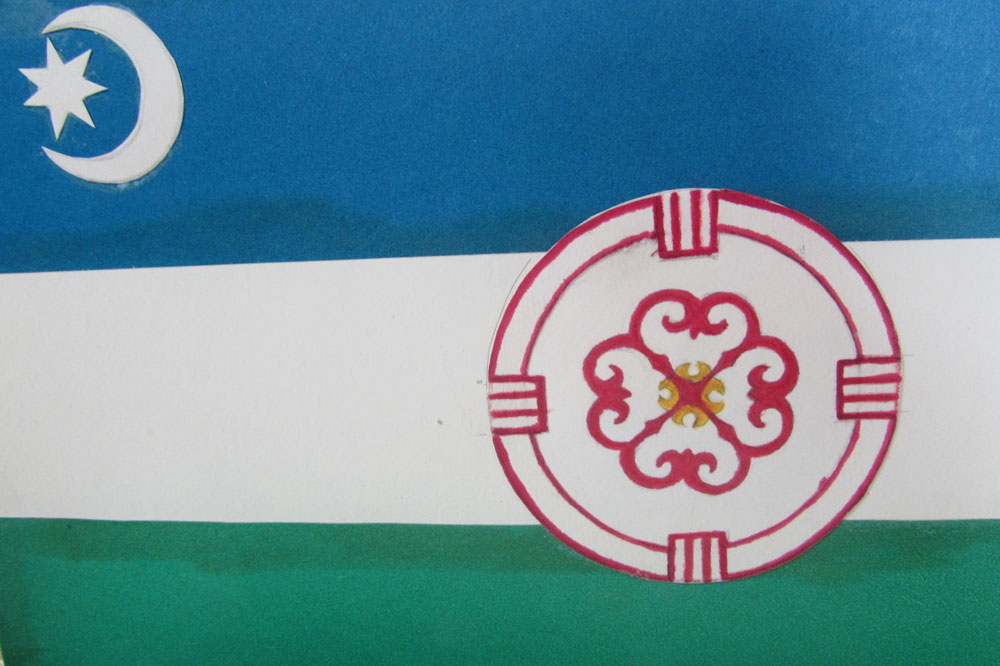
Project of the National Flag, 1992
As for the size of the flag, the ratio of its width to length is two to three. This corresponds to the generally accepted traditions.
The presented version of the flag - one-color, blue-blue color with three symbols was discussed for a long time. According to the laws of heraldry, the first rule is that all symbols be readable and more objective. In the event that they affect any abstractive category, then this abstraction should be readable and symbolic. The symbols must be at least three. The next is the abstraction of this symbol, which exists, one way or another, in some subject symbolism. The State Flag determines the overall symbolic burden of the republic.
The second variant of the flag was presented in the same color, in which the first variant was proposed. This is a flag with an image of an eagle and the sun. The meaning of the symbols should be clear to everyone, even non-professionals. At the same time, the symbols should reflect the specifics of the young state, who independently straightened its wings. This symbol was presented to the eagle. The blue sky and the sun as an integral part of nature and the unity of all the peoples of the republic.
The next variant of the flag was presented by the republican companies "Kazakh Tili" and "Elimai". According to the laws of heraldry, the banner should be seen both near and far, in the wind and in a calm state. The elements depicted on the banner should be two or three, not more. Any material has its own properties, whether it is wood, glass or fabric. Banner - on the fabric, so the image on it should be simple and concise. And the composition, graphics, and design should be simple and understandable to any person, meet national traditions. It must be a symbol depicting the bird's track and the face of a person.
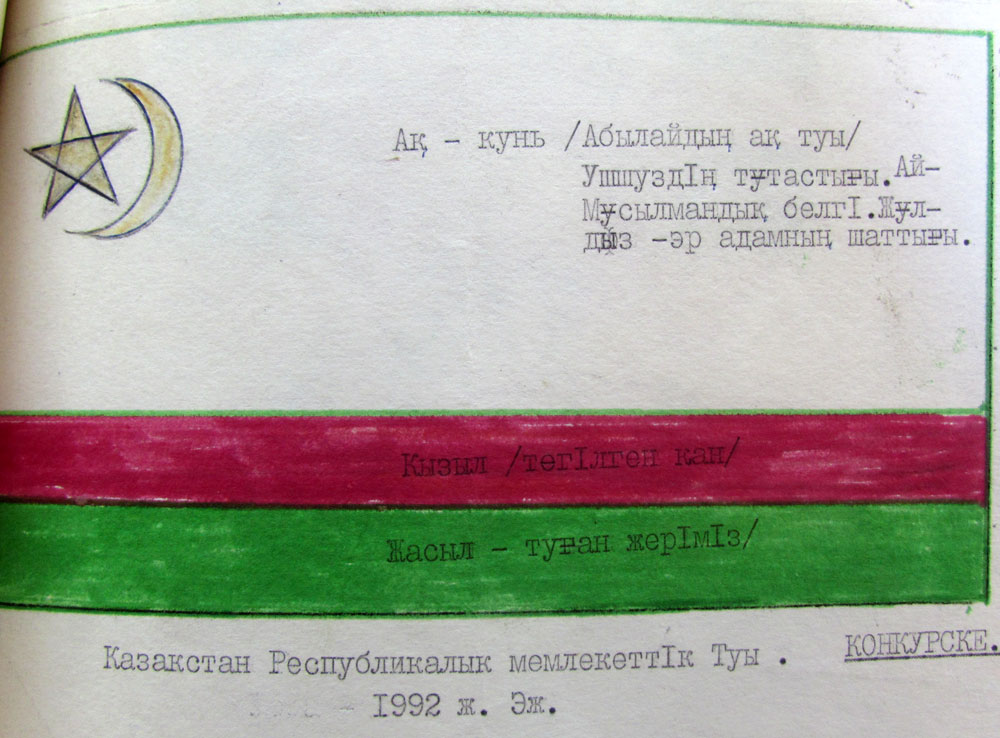
Project of the National Flag, 1992
The banner should be more stylized. It cannot be painted with oil paints on the wall. Therefore, there are certain laws and prospects. Our ancient symbols in a more stylized form should be returned now, so that they correspond to the design of the 20th century. In this regard, Baizhigitov B., an art critic, a member of the Artists' Union, told about some peculiarities of stylization, for example, about the features of the headdress of Kazakhs. On the one hand, it is really like a headdress, and on the other - both as a banner and as a bow. In this banner everyone can find a symbol close to his heart.
As for the color. Blue is the color of the morning sky. From time immemorial, Kazakhs were very careful and sacred to the blue color, it was never under their feet. This color is considered sacred among the Kazakhs.
Nature itself is made up of three primary colors. White is like a road to justice, purity. People buried in white cloth. Green is the symbol of Islam. Red is usually associated with fire. Red color is a sign of the entire Turkic-speaking population; this is the blood of innocent victims, dead.
The Kazakhs accepted that the shanyrak should be high. Therefore, they put shanyrak in holy places. When there was a misfortune, shanyrak broke up.
As for the month. As a rule, the crescent and the stars were depicted in mosques and mazars. The sun bore the symbol of light. The chapels depicted the sun. The mausoleum of Ahmed Yassawi is a testament to this, there is also a picture of the sun.
The best project of the national flag was a variant presented by the author's team consisting of architect Ualikhanov Shota Idrisovich, artist Niyazbekov Shaken Ondasynovich, People's Deputy of the Republic, a Designer Suleimenov Timur Bimashevich and artist Tulepbaev Erbolat Togyzbayevich.
Translated by Raushan MAKHMETZHANOVA
